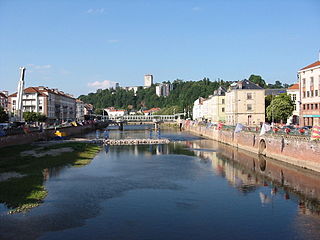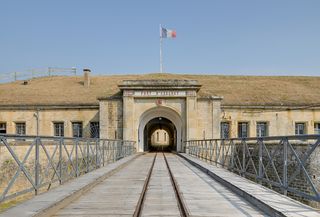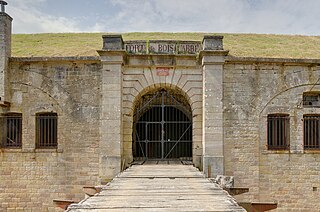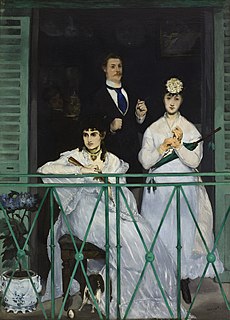
Édouard Manet was a French modernist painter. He was one of the first 19th-century artists to paint modern life, as well as a pivotal figure in the transition from Realism to Impressionism.

Impressionism is a 19th-century art movement characterized by relatively small, thin, yet visible brush strokes, open composition, emphasis on accurate depiction of light in its changing qualities, ordinary subject matter, unusual visual angles, and inclusion of movement as a crucial element of human perception and experience. Impressionism originated with a group of Paris-based artists whose independent exhibitions brought them to prominence during the 1870s and 1880s.

Vosges is a department in the Grand Est region in Northeastern France. It covers part of the Vosges mountain range, after which it is named. Vosges consists of 17 cantons and 507 communes, 273 of which are classified as urban and of which 234 are classified as rural, including Domrémy-la-Pucelle, where Joan of Arc was born. In 2017, it had a population of 367,673 with an area of 5,874 km2 ; its prefecture is Épinal.

Aquatint is an intaglio printmaking technique, a variant of etching that produces areas of tone rather than lines. For this reason it has mostly been used in conjunction with etching, to give both lines and shaded tone. It has also been used historically to print in colour, both by printing with multiple plates in different colours, and by making monochrome prints that were then hand-coloured with watercolour.

Épinal is a commune in northeastern France and the prefecture of the Vosges department.

Le Déjeuner sur l'herbe – originally titled Le Bain – is a large oil on canvas painting by Édouard Manet created in 1862 and 1863. It depicts a female nude and a scantily dressed female bather on a picnic with two fully dressed men in a rural setting. Rejected by the Salon jury of 1863, Manet seized the opportunity to exhibit this and two other paintings in the 1863 Salon des Refusés, where the painting sparked public notoriety and controversy. The work is now in the Musée d'Orsay in Paris. A smaller, earlier version can be seen at the Courtauld Gallery, London.

Olympia is a painting by Édouard Manet, first exhibited at the 1865 Paris Salon, which shows a nude woman ("Olympia") lying on a bed being brought flowers by a servant. Olympia was modelled by Victorine Meurent and Olympia's servant by the art model Laure. Olympia's confrontational gaze caused shock and astonishment when the painting was first exhibited because a number of details in the picture identified her as a prostitute. The French government acquired the painting in 1890 after a public subscription organized by Claude Monet. The painting is on display at the Musée d'Orsay, Paris.

The Nude Maja is a name given to a c. 1797–1800 oil on canvas painting by the Spanish artist Francisco Goya. It portrays a nude woman reclining on a bed of pillows, and was probably commissioned by Manuel de Godoy, to hang in his private collection in a separate cabinet reserved for nude paintings. Goya created a pendant of the same woman identically posed, but clothed, known today as La maja vestida ; also in the Prado, it is usually hung next to La maja desnuda. The subject is identified as a maja based on her costume in La maja vestida.

Victorine-Louise Meurent was a French painter and a model for painters. Although she is best known as the favorite model of Édouard Manet, she became an artist in her own right who regularly exhibited at the prestigious Paris Salon. In 1876, her paintings were selected for inclusion at the Salon's juried exhibition, when Manet's work was not.

The Third of May 1808 is a painting completed in 1814 by the Spanish painter Francisco Goya, now in the Museo del Prado, Madrid. In the work, Goya sought to commemorate Spanish resistance to Napoleon's armies during the occupation of 1808 in the Peninsular War. Along with its companion piece of the same size, The Second of May 1808, it was commissioned by the provisional government of Spain at Goya's suggestion.

The Image Club d'Épinal, known as Gamyo d'Épinal for sponsorship reasons, is a French ice hockey team based in Épinal playing in the Ligue Magnus. The team was formerly known as the "Dauphins d'Épinal", until a French video game company, Gamyo, bought the naming rights in 2014. The team was founded in 1997 and plays home games at the Patinoire de Poissompré.

The Fort d'Uxegney, or Fort Roussel, is part of the fortifications of Épinal. It was built near the village of Uxegney between 1882 and 1884, and was modernized in 1910. It is an example of a Séré de Rivières system fortification. It retains its armament and is maintained as a museum.

The Fort de Bois l'Abbé, or Fort Poniatowski, is part of the fortifications of Épinal, France. It was built near the village of Uxegney between 1883 and 1885. It is an example of a Séré de Rivières system fortification. It escaped significant alteration in the years prior to World War I and is maintained as a museum.

The Fort des Adelphes, or Fort Richepance, is part of the fortifications of Épinal. It was built near the village of Deyvillers between 1883 and 1885, and was modernized beginning in 1907. It is an example of a Séré de Rivières system fortification. During World War II the fort surrendered to German forces and was then used by the Germans to fire on neighboring forts Longchamp and Dogneville. The fort is now occupied by an activity of the French Air Force associated with Base aerienne 133 Nancy-Ochey and is not accessible to the public.

Adolphe Étienne Auguste Moreau-Nélaton was a French painter, art collector and art historian. His large collection is today held in its entirety by French national museums.

The Balcony is an 1868-69 oil painting by the French painter Édouard Manet. It depicts four figures on a balcony, one of whom is sitting: the painter Berthe Morisot, who married Manet's brother Eugène in 1874. In the centre is the painter Jean Baptiste Antoine Guillemet. On the right is Fanny Claus, a violinist. The fourth figure, partially obscured in the interior's background, is possibly Léon Leenhoff, Manet's son. It was exhibited at the Paris Salon of 1869, and then kept by Manet until his death in 1883. It was sold to the painter Gustave Caillebotte in 1884, who left it to the French state in 1894. It is currently held at the Musée d'Orsay, in Paris.

The Battle of the Kearsarge and the Alabama is an 1864 oil painting by Édouard Manet. The painting commemorates the Battle of Cherbourg of 1864, a naval engagement of the American Civil War between the Union cruiser USS Kearsarge and the Confederate raider CSS Alabama. Many spectators were able to see the battle from the coast of France and saw that USS Kearsarge sank CSS Alabama. Not having witnessed the battle himself, Manet relied on press descriptions of the fight to document his work. Within one month of this battle, Manet had already completed this painting and got it on display in the print shop of Alfred Cadart in Paris.
Prostitution in Impressionist painting was a common subject in the art of the period. Prostitution was a very widespread phenomenon in nineteenth-century Paris and although an accepted practice among the nineteenth century bourgeoisie, it was nevertheless a topic that remained largely taboo in polite society. As a result, Impressionist works depicting the prostitute often became the subject of scandal, and particularly venomous criticism. Some works showed her with considerable sympathy, while others attempted to impart an agency to her; likewise some work showed high-class courtesans, and others prostitutes awaiting clients on the streets. In addition to the sexual revulsion/attraction the figure of the prostitute stirred, she functioned as a sign of modernity, a clear sign of the entanglement of sex, class, power and money.

Argenteuil is an 1874 oil on canvas painting by Édouard Manet (1832-1883), first exhibited at the Paris Salon of 1875. It is one of Manet's first works to qualify fully as an Impressionist work, due to its naturalistic subject and its bold palette, such as the blue of the river, mocked by the Figaro journalist Jean Rousseau as "in the foreground, Argenteuil jam on an indigo river" It is now in the Musée des beaux-arts in Tournai, Belgium.

Madame Manet in the Conservatory is an 1879 oil on canvas painting by Édouard Manet of his wife Suzanne. It is now in the National Gallery in Oslo, Norway.
























